Assessment of Ammonia Emissions and Greenhouse Gases in Dairy Cattle Facilities: A Bibliometric Analysis
Abstract
:Simple Summary
Abstract
1. Introduction
2. Materials and Methods
2.1. Scientific Database Selection
2.2. Data Research Criteria
2.3. Selection Procedures and Data Organization
2.4. Data Analysis
2.5. Data Interpretation
3. Results and Discussion
3.1. Annual Scientific Publications on Gases in Dairy Cattle Farming
3.2. Main Gases Studied in Scientific Articles over the Years
3.3. Impacts of Livestock Manure Emissions on Environmental Sustainability and Animal Welfare
3.4. Gas Emissions by Type of Facility
3.5. Publications by Countries and Connection Networks
3.6. Relevant Journal
3.7. Most Relevant Papers and Their Characteristics
3.8. Author Co-Citation Analysis
3.9. Relevant Institutions
3.10. Keywords Related to NH3 and GHG Emissions in Dairy Cattle Housing Systems
3.11. Trends in Gases Emission Research
3.12. Limitations of the Study
4. Conclusions
Author Contributions
Funding
Institutional Review Board Statement
Informed Consent Statement
Data Availability Statement
Acknowledgments
Conflicts of Interest
References
- Schrobback, P.; Dennis, G.; Li, Y.; Mayberry, D.; Shaw, A.; Knight-Jones, T.; Marsh, T.L.; Pendell, D.L.; Torgerson, P.R.; Gilbert, W.; et al. Approximating the global economic (market) value of farmed animals. Glob. Food Secur. 2023, 39, 100722. [Google Scholar] [CrossRef] [PubMed]
- Zhuang, M.; Shan, N.; Wang, Y.; Caro, D.; Fleming, R.M.; Wang, L. Different characteristics of greenhouse gases and ammonia emissions from conventional stored dairy cattle and swine manure in China. Sci. Total Environ. 2020, 722, 137693. [Google Scholar] [CrossRef] [PubMed]
- National Research Council. Air Emissions from Animal Feeding Operations: Current Knowledge, Future Needs; The National Academies Press: Washington, DC, USA, 2003.
- Cecchini, L.; Venanzi, S.; Pierri, A.; Chiorri, M. Environmental efficiency analysis and estimation of CO2 abatement costs in dairy cattle farms in Umbria (Italy): A SBM-DEA model with undesirable output. J. Clean. Prod. 2018, 197, 895–907. [Google Scholar] [CrossRef]
- Naranjo, A.; Johnson, A.; Rossow, H.; Kebreab, E. Greenhouse gas, water, and land footprint per unit of production of the California dairy industry over 50 years. J. Dairy Sci. 2020, 103, 3760–3773. [Google Scholar] [CrossRef] [PubMed]
- Amon, B.; Kryvoruchko, V.; Amon, T.; Zechmeister-Boltenstern, S. Methane, nitrous oxide and ammonia emissions during storage and after application of dairy cattle slurry and influence of slurry treatment. Agric. Ecosyst. Environ. 2006, 112, 153–162. [Google Scholar] [CrossRef]
- Shi, Z.; Xi, L.; Zhao, X. Measurement of ammonia and hydrogen sulfide emission from three typical dairy barns and estimation of total ammonia emission for the Chinese dairy industry. Animals 2023, 13, 2301. [Google Scholar] [CrossRef] [PubMed]
- Zanon, T.; Fichter, G.; Mittermair, P.; Nocker, L.; Gauly, M.; Peratoner, G. Quantifying methane emissions under field conditions under 2 different dairy production scenarios: Low-input versus high-input milk production. J. Dairy Sci. 2023, 106, 4711–4724. [Google Scholar] [CrossRef] [PubMed]
- Schmithausen, A.J.; Schiefler, I.; Trimborn, M.; Gerlach, K.; Südekum, K.-H.; Pries, M.; Büscher, W. Quantification of methane and ammonia emissions in a naturally ventilated barn by using defined criteria to calculate emission rates. Animals 2018, 8, 75. [Google Scholar] [CrossRef] [PubMed]
- Hu, E.; Babcock, E.L.; Bialkowski, S.E.; Jones, S.B.; Tuller, M. Methods and techniques for measuring gas emissions from agricultural and animal feeding operations. Crit. Rev. Anal. Chem. 2014, 44, 200–219. [Google Scholar] [CrossRef] [PubMed]
- Chistov, V.; Aramburu, N.; Carrillo-Hermosilla, J. Open eco-innovation: A bibliometric review of emerging research. J. Clean. Prod. 2021, 311, 127627. [Google Scholar] [CrossRef]
- Marin, D.B.; Becciolini, V.; Santana, L.S.; Rossi, G.; Barbari, M. State of the art and future perspectives of atmospheric chemical sensing using unmanned aerial vehicles: A bibliometric analysis. Sensors 2023, 23, 8384. [Google Scholar] [CrossRef] [PubMed]
- Donthu, N.; Kumar, S.; Mukherjee, D.; Pandey, N.; Lim, W.M. How to conduct a bibliometric analysis: An overview and guidelines. J. Bus. Res. 2021, 133, 285–296. [Google Scholar] [CrossRef]
- Sarkar, A.; Wang, H.; Rahman, A.; Memon, W.H.; Qian, L. A bibliometric analysis of sustainable agriculture: Based on the web of science (WOS) platform. Environ. Sci. Pollut. Res. 2022, 29, 38928–38949. [Google Scholar] [CrossRef] [PubMed]
- Su, Y.; Yu, Y.; Zhang, N. Carbon emissions and environmental management based on big data and streaming data: A bibliometric analysis. Sci. Total Environ. 2020, 733, 138984. [Google Scholar] [CrossRef] [PubMed]
- Santana, L.S.; Ferraz, G.A.e.S.; Teodoro, A.J.d.S.; Santana, M.S.; Rossi, G.; Palchetti, E. Advances in precision coffee growing research: A bibliometric review. Agronomy 2021, 11, 1557. [Google Scholar] [CrossRef]
- Silva, G.G.B.S.; Ferraz, P.F.P.; Damasceno, F.A.; Zotti, M.L.A.N.; Barbari, M. Compost Barns: A bibliometric analysis. Animals 2022, 12, 2492. [Google Scholar] [CrossRef] [PubMed]
- Vitorino Filho, V.A.; Goi, M.Y.O. Supply chain management 4.0: Content analysis in the most relevant articles from Scopus and Web of Science databases. Braz. J. Dev. 2021, 7, 117868–117889. [Google Scholar] [CrossRef]
- Bakkalbasi, N.; Bauer, K.; Glover, J.; Wang, L. Three options for citation tracking: Google Scholar, Scopus and Web of Science. Biomed. Digit. Libr. 2006, 3, 7. [Google Scholar] [CrossRef] [PubMed]
- Geng, Y.; Chen, W.; Liu, Z.; Chiu, A.S.F.; Han, W.; Liu, Z.; Zhong, S.; Qian, Y.; You, W.; Cui, X. A bibliometric review: Energy consumption and greenhouse gas emissions in the residential sector. J. Clean. Prod. 2017, 159, 301–316. [Google Scholar] [CrossRef]
- Van Eck, N.J.; Waltman, L.A. Comparison of two techniques for bibliometric mapping: Multidimensional scaling and VOS. J. Am. Soc. Inf. Sci. Technol. 2010, 61, 2405–2416. [Google Scholar] [CrossRef]
- Ryden, J.C.; Whitehead, D.C.; Lockyer, D.R.; Thompson, R.B.; Skinner, J.H.; Garwood, E.A. Ammonia emission from grassland and livestock production systems in the UK. Environ. Pollut. 1987, 48, 173–184. [Google Scholar] [CrossRef]
- Leggett, J.A. The United Nations Framework Convention on Climate Change, the Kyoto Protocol, and the Paris Agreement: A Summary; UNFCCC: New York, NY, USA, 2020; v. 2. [Google Scholar]
- Intergovernmental Panel on Climate Change—IPCC. Guidelines for National Greenhouse Gas Inventories; Institute for Global Environmental Strategies (IGES): Hayama, Japan, 2006; ISBN 4-88788-032-4. Available online: https://www.ipcc-nggip.iges.or.jp/public/2006gl/index.html (accessed on 9 May 2024).
- Caro, D.; Davis, S.J.; Bastianoni, S.; Caldeira, K. Global and regional trends in greenhouse gas emissions from livestock. Clim. Change 2014, 126, 203–216. [Google Scholar] [CrossRef]
- Lamb, W.F.; Grubb, M.; Diluiso, F.; Minx, J.C. Countries with sustained greenhouse gas emissions reductions: An analysis of trends and progress by sector. Clim. Policy 2022, 22, 1–17. [Google Scholar] [CrossRef]
- Dubash, N.K.; Hagemann, M.; Höhne, N.; Upadhyaya, P. Developments in national climate change mitigation legislation and strategy. Clim. Policy 2013, 13, 649–664. [Google Scholar] [CrossRef]
- Fankhauser, S.; Gennaioli, C.; Collins, M. Do international factors influence the passage of climate change legislation? Clim. Policy 2016, 16, 318–331. [Google Scholar] [CrossRef]
- Aguerre, M.J.; Wattiaux, M.A.; Powell, J.M. Emissions of ammonia, nitrous oxide, methane, and carbon dioxide during storage of dairy cow manure as affected by dietary forage-to-concentrate ratio and crust formation. J. Dairy Sci. 2012, 95, 7409–7416. [Google Scholar] [CrossRef] [PubMed]
- Aguerre, M.J.; Wattiaux, M.A.; Powell, J.M.; Broderick, G.A.; Arndt, C. Effect of forage-to-concentrate ratio in dairy cow diets on emission of methane, carbon dioxide, and ammonia, lactation performance, and manure excretion. J. Dairy Sci. 2011, 94, 3081–3093. [Google Scholar] [CrossRef] [PubMed]
- Adviento-Borbe, M.A.A.; Wheeler, E.F.; Brown, N.E.; Topper, P.A.; Graves, R.E.; Ishler, V.A.; Varga, G.A. Ammonia and greenhouse gas flux from manure in freestall barn with dairy cows on precision fed rations. Trans. ASABE 2010, 53, 1251–1266. [Google Scholar] [CrossRef]
- Li, L.; Cyriac, J.; Knowlton, K.F.; Marr, L.C.; Gay, S.W.; Hanigan, M.D.; Ogejo, J.A. Effects of reducing dietary nitrogen on ammonia emissions from manure on the floor of a naturally ventilated free stall dairy barn at low (0–20 °C) temperatures. J. Environ. Qual. 2009, 38, 2172–2181. [Google Scholar] [CrossRef] [PubMed]
- Odongo, N.E.; Or-Rashid, M.M.; Kebreab, E.; France, J.; McBride, B.W. Effect of supplementing myristic acid in dairy cow rations on ruminal methanogenesis and fatty acid profile in milk. J. Dairy Sci. 2007, 90, 1851–1858. [Google Scholar] [CrossRef]
- Snoek, D.J.W.; Stigter, J.D.; Blaauw, S.K.; Groot Koerkamp, P.W.G.; Ogink, N.W.M. Assessing fresh urine puddle physics in commercial dairy cow houses. Biosyst. Eng. 2017, 159, 133–142. [Google Scholar] [CrossRef]
- Yajima, A.; Owada, H.; Kobayashi, S.; Komatsu, N.; Takehara, K.; Ito, M.; Matsuda, K.; Sato, K.; Itabashi, H.; Sugimura, S.; et al. Cacao bean husk: An applicable bedding material in dairy free-stall barns. Asian-Australas. J. Anim. Sci. 2016, 30, 1048–1053. [Google Scholar] [CrossRef]
- Mathot, M.; Decruyenaere, V.; Lambert, R.; Stilmant, D. Deep litter removal frequency rate influences on greenhouse gas emissions from barns for beef heifers and from manure stores. Agric. Ecosyst. Environ. 2016, 233, 94–105. [Google Scholar] [CrossRef]
- Hristov, A.N.; Heyler, K.; Schurman, E.; Griswold, K.; Topper, P.; Hile, M.; Ishler, V.; Fabian-Wheeler, E.; Dinh, S. Case study: Reducing dietary protein decreased the ammonia emitting potential of manure from commercial dairy farms. Prof. Anim. Sci. 2015, 31, 68–79. [Google Scholar] [CrossRef]
- Fangueiro, D.; Coutinho, J.; Chadwick, D.; Moreira, N.; Trindade, H. Effect of cattle slurry separation on greenhouse gas and ammonia emissions during storage. J. Environ. Qual. 2008, 37, 2322–2331. [Google Scholar] [CrossRef] [PubMed]
- Kuhla, B.; Viereck, G. Enteric methane emission factors, total emissions and intensities from Germany’s livestock in the late 19th century: A comparison with the today’s emission rates and intensities. Sci. Total Environ. 2022, 848, 157754. [Google Scholar] [CrossRef] [PubMed]
- Becciolini, V.; Conti, L.; Rossi, G.; Marin, D.B.; Merlini, M.; Coletti, G.; Rossi, U.; Barbari, M. Real-time measurements of gaseous and particulate emissions from livestock buildings and manure stores with novel UAV-based system. In AIIA 2022: Biosystems Engineering towards the Green Deal; Springer International Publishing: Cham, Switzerland, 2023; pp. 1049–1056. ISBN 9783031303289. [Google Scholar] [CrossRef]
- Zou, B.; Shi, Z.X.; Du, S.H. Gases emissions estimation and analysis by using carbon dioxide balance method in natural-ventilated dairy cow barns. Int. J. Agric. Biol. Eng. 2020, 13, 41–47. [Google Scholar] [CrossRef]
- Tremblay, F.J.B.; Massé, D.I.; Bluteau, C.V. Accuracy assessment of methane emissions measurement systems tailored to mechanically ventilated livestock buildings. Can. Biosyst. Eng. 2014, 56, 1–7. [Google Scholar] [CrossRef]
- Zhu, Z.; Dong, H.; Zhou, Z. Ammonia and greenhouse gas emissions from a dairy cattle barn with a daily manure collection system. Trans. ASABE 2012, 55, 1959–1964. [Google Scholar] [CrossRef]
- Schrade, S.; Keck, M.; Zeyer, K.; Emmenegger, L. Housing systems and a concept to measure ammonia emissions in case of natural ventilation. Rech. Agron. Suisse 2011, 2, 170–175. [Google Scholar]
- Sikiru, A.B.; Makinde, O.J.; Koura, B.I.; Acheneje, S.S.E.; Alabi, J.O.; Shipandeni, M.N.T.; Akinsola, O.M. Bibliometric mapping of academic research focusing on animal production and climate change in association with methane emissions and animal productivity. Ruminants 2024, 4, 152–164. [Google Scholar] [CrossRef]
- Drewry, J.L.; Choi, C.Y.; Powell, J.M.; Luck, B.D. Computational model of methane and ammonia emissions from dairy barns: Development and validation. Comput. Electron. Agric. 2018, 149, 80–89. [Google Scholar] [CrossRef]
- Owen, J.J.; Silver, W.L. Greenhouse gas emissions from dairy manure management: A review of field-based studies. Glob. Chang. Biol. 2015, 21, 550–565. [Google Scholar] [CrossRef] [PubMed]
- Qu, Q.; Groot, J.C.J.; Zhang, K.; Schulte, R.P.O. Effects of housing system, measurement methods and environmental factors on estimating ammonia and methane emission rates in dairy barns: A meta-analysis. Biosyst. Eng. 2021, 205, 64–75. [Google Scholar] [CrossRef]
- United States Environmental Protection Agency—USEPA. National Emission Inventory—Ammonia Emissions from Animal Husbandry Operations; United States Environmental Protection Agency: Washington, DC, USA, 2004. Available online: https://www3.epa.gov/ttn/chief/ap42/ch09/related/nh3inventorydraft_jan2004.pdf (accessed on 9 May 2024).
- Baceninaite, D.; Dzermeikaite, K.; Antanaitis, R. Global warming and dairy cattle: How to control and reduce methane emission. Animals 2022, 12, 2687. [Google Scholar] [CrossRef] [PubMed]
- United States Environmental Protection Agency—USEPA. Global Anthropogenic Non-CO2 Greenhouse Gas Emissions: 1990–2020; United States Environmental Protection Agency: Washington, DC, USA, 2006. Available online: https://nepis.epa.gov/Exe/ZyPDF.cgi/2000ZL5G.PDF?Dockey=2000ZL5G.PDF (accessed on 9 May 2024).
- Stokstad, E. Ammonia pollution from farming may exact hefty health costs. Science 2014, 343, 238. [Google Scholar] [CrossRef]
- Hamilton, S.W.; DePeters, E.J.; McGarvey, J.A.; Lathrop, J.; Mitloehner, F.M. Greenhouse gas, animal performance, and bacterial population structure responses to dietary monensin fed to dairy cows. J. Environ. Qual. 2010, 39, 106–114. [Google Scholar] [CrossRef] [PubMed]
- Stokstad, M.; Klem, T.B.; Myrmel, M.; Oma, V.S.; Toftaker, I.; Osteras, O.; Nodtvedt, A. Using biosecurity measures to combat respiratory disease in cattle: The Norwegian control program for bovine respiratory syncytial virus and bovine Coronavirus. Front. Vet. Sci. 2020, 7, 167. [Google Scholar] [CrossRef] [PubMed]
- Almeida, J.G.R.; Lorinquer, E.; Robin, P.; Ribeiro-Filho, H.M.N.; Edouard, N. Ammonia and nitrous oxide emissions from dairy cows on straw-based litter systems. Atmosphere 2022, 13, 283. [Google Scholar] [CrossRef]
- Intergovernmental Panel on Climate Change—IPCC. Climate Change 2001: The Scientific Basis; Cambridge University: Cambridge, UK, 2001; ISBN 0521 01495 6. [Google Scholar]
- Wecking, A.R.; Wall, A.M.; Liáng, L.L.; Lindsey, S.B.; Luo, J.; Campbell, D.I.; Schipper, L.A. Reconciling annual nitrous oxide emissions of an intensively grazed dairy pasture determined by eddy covariance and emission factors. Agric. Ecosyst. Environ. 2020, 287, 106646. [Google Scholar] [CrossRef]
- Intergovernmental Panel on Climate Change—IPCC. Climate Change 2013: The Physical Science Basis; Cambridge University: Cambridge, UK; New York, NY, USA, 2013; ISBN 978-1-107-66182-0. [Google Scholar]
- Heinzen, T. Recent developments in the quantification and regulation of air emissions from animal feeding operations. Curr. Environ. Health Rep. 2015, 2, 25–32. [Google Scholar] [CrossRef]
- Shi, Z.F.; Sun, X.Q.; Lu, Y.; Xi, L.; Zhao, X. Emissions of ammonia and hydrogen sulfide from typical dairy barns in central China and major factors influencing the emissions. Sci. Rep. 2019, 9, 13821. [Google Scholar] [CrossRef] [PubMed]
- Ribeiro-Filho, H.M.N.; Civiero, M.; Kebreab, E. Potential to reduce greenhouse gas emissions through different dairy cattle systems in subtropical regions. PLoS ONE 2020, 15, e0234687. [Google Scholar] [CrossRef] [PubMed]
- Uçtug, F.G. The environmental life cycle assessment of dairy products. Food Eng. Rev. 2019, 11, 104–121. [Google Scholar] [CrossRef]
- Guzmán-Luna, P.; Mauricio-Iglesias, M.; Flysjo, A.; Hospido, A. Analysing the interaction between the dairy sector and climate change from a life cycle perspective: A review. Trends Food Sci. Technol. 2022, 126, 168–179. [Google Scholar] [CrossRef]
- Dzermeikaite, K.; Kristolaityte, J.; Antanaitis, R. Relationship between dairy cow health and intensity of greenhouse gas emissions. Animals 2024, 14, 829. [Google Scholar] [CrossRef] [PubMed]
- Jia, X.; Zhang, Z.; Wang, F.; Li, Z.; Wang, Y.; Aviso, K.B.; Wang, Y.; Aviso, K.B.; Foo, D.Y.C.; Nair, P.N.S.B.; et al. Regional carbon drawdown with enhanced weathering of non-hazardous industrial wastes. Resour. Conserv. Recycl. 2022, 176, 105910. [Google Scholar] [CrossRef]
- Herzog, A.; Winckler, C.; Zollitsch, W. In pursuit of sustainability in dairy farming: A review of interdependent effects of animal welfare improvement and environmental impact mitigation. Agric. Ecosyst. Environ. 2018, 267, 174–187. [Google Scholar] [CrossRef]
- Singaravadivelan, A.; Sachin, P.B.; Harikumar, S.; Vijayakumar, P.; Vindhya, M.V.; Farhana, F.M.B.; Rameesa, K.K.; Mathew, J. Life cycle assessment of greenhouse gas emission from the dairy production system. Trop. Anim. Health Prod. 2023, 55, 320. [Google Scholar] [CrossRef] [PubMed]
- Sanchis, E.; Calvet, S.; del Prado, A.; Estellés, F. A meta-analysis of environmental factor effects on ammonia emissions from dairy cattle houses. Biosyst. Eng. 2019, 178, 176–183. [Google Scholar] [CrossRef]
- Zhang, N.; Bai, Z.; Winiwarter, W.; Luo, J.; Liu, J.; Guo, Y.; Ma, L. Environmental modeling reducing ammonia emissions from dairy cattle production via cost-effective manure management techniques in China reducing ammonia emissions from dairy cattle production via cost-effective manure management techniques in China. Environ. Sci. Technol. 2019, 53, 11840–11848. [Google Scholar] [CrossRef] [PubMed]
- Intergovernmental Panel on Climate Change—IPCC. Climate Change 2022: Impacts, Adaptation and Vulnerability; Contribution of Working Group II to the Sixth Assessment Report of the Intergovernmental Panel on Climate Change; Cambridge University Press: Cambridge, UK; New York, NY, USA, 2022. [Google Scholar] [CrossRef]
- Intergovernmental Panel on Climate Change—IPCC. Climate Change 2014: Impacts, Adaptation, and Vulnerability. Part B: Regional Aspects: Working Group II Contribution to the Fifth Assessment Report of the Intergovernmental Panel on Climate Change (2014); Cambridge University Press: Cambridge, UK; New York, NY, USA, 2014. [Google Scholar] [CrossRef]
- Calzadilla, A.; Rehdanz, K.; Betts, R.; Falloon, P.; Wiltshire, A.; Tol, R.S.J. Climate change impacts on global agriculture. Clim. Chang. 2013, 120, 357–374. [Google Scholar] [CrossRef]
- Fodor, N.; Foskolos, A.; Topp, C.F.E.; Moorby, J.M.; Pásztor, L.; Foyer, C.H. Spatially explicit estimation of heat stress-related impacts of climate change on the milk production of dairy cows in the United Kingdom. PLoS ONE 2018, 13, e0197076. [Google Scholar] [CrossRef]
- Food and Agriculture Organization. Climate Change: Unpacking the Burden on Food Safety; Food safety and quality; Food and Agriculture Organization: Rome, Italy, 2019; 176p, ISBN 978-92-5-132293-2. [Google Scholar]
- Molina, L.; Agüera, E.I.; Pérez-Marín, C.C.; Maroto-Molina, F. Comparing welfare indicators in dairy cattle under different loose housing systems (deep litter vs. cubicle barns) using recycled manure solids for bedding. Span. J. Agric. Res. 2020, 18, e0501. [Google Scholar] [CrossRef]
- Galama, P.J.; Ouweltjes, W.; Endres, M.I.; Sprecher, J.R.; Leso, L.; Kuipers, A.; Klopčič, M. Symposium review: Future of housing for dairy cattle. J. Dairy Sci. 2020, 103, 5759–5772. [Google Scholar] [CrossRef] [PubMed]
- Bewley, J.M.; Robertson, L.M.; Eckelkamp, E.A. A 100-Year Review: Lactating dairy cattle housing management. J. Dairy Sci. 2017, 100, 10418–10431. [Google Scholar] [CrossRef] [PubMed]
- Mota, V.C.; Campos, A.T.; Damasceno, F.A.; Resende, E.A.d.M.; Rezende, C.P.d.A.; Abreu, L.R.d.; Vareiro, T. Confinamento para bovinos leiteiros: Histórico e características. PubVet 2017, 11, 433–442. [Google Scholar] [CrossRef]
- Kupper, T.; Hania, C.; Neftelb, A.; Kincaidc, C.; Buhlera, M.; Amonf, B.; Vander Zaagc, A. Ammonia and greenhouse gas emissions from slurry storage—A review. Agric. Ecosyst. Environ. 2020, 300, 106963. [Google Scholar] [CrossRef]
- Sommer, S.G.; Petersen, S.O.; Sorensen, P.; Poulsen, H.D.; Moller, H.B. Methane and carbon dioxide emissions and nitrogen turnover during liquid manure storage. Nutr. Cycl. Agroecosyst. 2007, 78, 27–36. [Google Scholar] [CrossRef]
- McIlroy, J.P.; McGeough, K.L.; Laughlin, R.J.; Carolan, R. Abatement of ammonia emissions from dairy cow house concrete floor surfaces through additive application. Biosyst. Eng. 2019, 188, 320–330. [Google Scholar] [CrossRef]
- Wang, X.; Wang, Z.; Zhang, X. Modeling of airflow patterns and CO2 dispersion in a ventilated space for dairy cattle. Biosyst. Eng. 2006, 93, 75–87. [Google Scholar]
- Uddin, M.E.; Larson, R.A.; Wattiaux, M.A. Effects of dairy cow breed and dietary forage on greenhouse gas emissions from manure during storage and after field application. J. Clean. Prod. 2020, 270, 122461. [Google Scholar] [CrossRef]
- Beaver, A.; Ritter, C.; von Keyserlingk, M.A.G. The Dairy Cattle Housing Dilemma. Vet. Clin. Food Anim. Pract. 2019, 35, 11–27. [Google Scholar] [CrossRef]
- Schils, R.L.M.; Philipsen, A.P.; Holshof, G.; Zom, R.L.G.; Hoving, I.E.; Van Reenen, C.G.; Van der Werf, J.T.N.; Galama, P.J.; Sebek, L.; Klootwijk, C.W.; et al. Amazing Grazing: Science in support of future grass based dairy systems. In Sustainable Meat and Milk Production from Grasslands; Wageningen Academic Publishers (Grassland Science in Europe): Wageningen, The Netherlands, 2018; Volume 23, pp. 336–338. [Google Scholar]
- PBL Netherlands Environmental Assessment Agency. Trends in Global CO2 Emissions: 2015 Report; PBL Netherlands Environmental Assessment Agency: Hague, The Netherlands, 2015; Available online: https://www.pbl.nl/en/publications/trends-in-global-co2-emissions-2015-report (accessed on 9 May 2024).
- Statista. Production of Cow Milk Worldwide: Major Producers 2023. Available online: https://www.statista.com/statistics/268191/cow-milk-production-worldwide-top-producers/ (accessed on 21 March 2024).
- Jia, P.; Tu, Y.; Liu, Z.; Lai, Q.; Li, F.; Dong, L.; Diao, Q. Characterization and mitigation option of greenhouse gas emissions from lactating Holstein dairy cows in East China. J. Anim. Sci. Biotechnol. 2022, 13, 88. [Google Scholar] [CrossRef]
- Strateanu, A.G.; Sandu, M.; Ciornei, L.; Udrea, L. Trends and innovative solutions in smart growth production of milk and dairy products. Valahia Univ. Targoviste Agric. 2023, 15, 35–41. [Google Scholar] [CrossRef]
- U.S. Department of Agriculture (USDA). 2021 U.S. Department of Agriculture (USDA) Climate-Smart Agriculture and Forestry Strategy: 90-Day Progress Report USDA; U.S. Department of Agriculture: Washington, DC, USA, 2021.
- Place, S.E.; McCabe, C.J.; Mitloehner, F.M. Symposium review: Defining a pathway to climate neutrality for US dairy cattle production. J. Dairy Sci. 2022, 105, 8558–8568. [Google Scholar] [CrossRef]
- Dupont, C.; Kulovesi, K.; Van Asselt, H. Governing the EU’s climate and energy transition through the 2030 Framework. Rev. Eur. Comp. Int’l Envtl. L. 2020, 29, 147. [Google Scholar] [CrossRef]
- Schreurs, M.A. The Paris climate agreement and the three largest emitters: China, the United States, and the European Union. Politics Gov. 2016, 4, 219–223. [Google Scholar] [CrossRef]
- Munidasa, S.; Eckard, R.; Sun, X.; Cullen, B.; McGill, D.; Chen, D.; Cheng, L. Challenges and opportunities for quantifying greenhouse gas emissions through dairy cattle research in developing countries. J. Dairy Res. 2021, 88, 3–7. [Google Scholar] [CrossRef]
- Bihari, A.; Tripathi, S.; Deepak, A. A review on h-index and its alternative indices. J. Inf. Sci. 2023, 49, 624–665. [Google Scholar] [CrossRef]
- Jokic, M. H-index as a new scientometric indicator. Biochem. Med. 2009, 19, 5–9. [Google Scholar] [CrossRef]
- Amon, B.; Amon, T.; Boxberger, J.; Alt, C. Emissions of NH3, N2O and CH4 from dairy cows housed in a farmyard manure tying stall (housing, manure storage, manure spreading). Nutr. Cycl. Agroecosyst. 2001, 60, 103–113. [Google Scholar] [CrossRef]
- Sommer, S.G.; Hutchings, N.J. Ammonia Emission from Field Applied Manure and Its Reduction. Eur. J. Agron. 2001, 15, 1–15. [Google Scholar] [CrossRef]
- Leytem, A.B.; Dungan, R.S.; Bjorneberg, D.L.; Koehn, A.C. Emissions of ammonia, methane, carbon dioxide, and nitrous oxide from dairy cattle housing and manure management systems. J. Environ. Qual. 2011, 40, 1383–1394. [Google Scholar] [CrossRef] [PubMed]
- Zhang, G.; Strom, J.S.; Li, B.; Rom, H.B.; Morsing, S.; Dahl, P.; Wang, C. Emission of ammonia and other contaminant gases from naturally ventilated dairy cattle buildings. Biosyst. Eng. 2005, 92, 355–364. [Google Scholar] [CrossRef]
- Weiske, A.; Vabitsch, A.; Olesen, J.E.; Schelde, K.; Michel, J.; Friedrich, R.; Kaltschmitt, M. Mitigation of greenhouse gas emissions in European conventional and organic dairy farming. Agric. Ecosyst. Environ. 2006, 112, 221–232. [Google Scholar] [CrossRef]
- Odongo, N.E.; Bagg, R.; Vessie, G.; Dick, P.; Or-Rashid, M.M.; Hook, S.E.; Gray, J.T.; Kebreab, E.; France, J.; McBride, B.W. Long-Term effects of feeding monensin on methane production in lactating dairy cows. J. Dairy Sci. 2007, 90, 1781–1788. [Google Scholar] [CrossRef]
- Sommer, S.G. Greenhouse gas emission and nitrogen turnover in stored liquid manure nutrient cycling in agroecosystems. Nutr. Cycl. Agroecosyst. 2007, 78, 27–36. [Google Scholar] [CrossRef]
- Jungbluth, T.; Hartung, E.; Brose, G. Greenhouse gas emissions from animal houses and manure stores. Nutr. Cycl. Agroecosyst. 2001, 60, 133–145. [Google Scholar] [CrossRef]
- Shaw, S.L.; Mitloehner, F.M.; Jackson, W.; DePeters, E.J.; Fadel, J.G.; Robinson, P.H.; Holzinger, R.; Goldstein, A.H. Volatile organic compound emissions from dairy cows and their waste as measured by proton-transfer-reaction mass spectrometry. Environ. Sci. Technol. 2007, 41, 1310–1316. [Google Scholar] [CrossRef] [PubMed]
- Zupic, I.; Cater, T. Bibliometric Methods in Management and Organization. Organ. Res. Methods 2015, 18, 429–472. [Google Scholar] [CrossRef]
- Hristov, A.N.; Oh, J.; Lee, C.; Meinen, R.; Montes, F.; Ott, T.; Firkins, J.; Rotz, A.; Dell, C.; Adesogan, A.; et al. Mitigation of Greenhouse Gas Emissions in Livestock Production—A Review of Technical Options for Non-CO2 Emissions; Pierre, J.G., Benjamin, H., Harinder, P.S.M., Eds.; FAO Animal Production and Health Paper, No. 177; FAO: Rome, Italy, 2013. [Google Scholar]
- Surwase, G.; Sagar, A.; Kademani, B.S.; Bhanumurthy, K. Co-citation Analysis: An Overview. In Beyond Librarianship: Creativity, Innovation and Discovery; C-DAC: Mumbai, India, 2011; pp. 16–17. Available online: https://core.ac.uk/download/pdf/290485458.pdf (accessed on 9 May 2024).
- White, H.D.; McCain, K.W. Visualizing a discipline: An author co-citation analysis of information science, 1972–1995. J. Am. Soc. Inf. Sci. 1998, 49, 327–355. [Google Scholar]
- Hristov, A.N.; Kebreab, E.; Niu, M.; Oh, J.; Bannink, A.; Bayat, A.R.; Boland, T.M.; Brito, A.F.; Casper, D.P.; Crompton, L.A.; et al. Symposium review: Uncertainties in enteric methane inventories, measurement techniques, and prediction models. J. Dairy Sci. 2018, 101, 6655–6674. [Google Scholar] [CrossRef] [PubMed]
- McGinn, S.M. Developments in micrometeorological methods for methane measurements. Animal 2013, 7, 386–393. [Google Scholar] [CrossRef] [PubMed]
- Powell, J.M.; Wattiaux, M.A.; Broderick, G.A. Short communication: Evaluation of milk urea nitrogen as a management tool to reduce ammonia emissions from dairy farms. J. Dairy Sci. 2011, 94, 4690–4694. [Google Scholar] [CrossRef] [PubMed]
- Flesch, T.K.; Harper, L.A.; Powell, J.M.; Wilson, J.D. Inverse-dispersion calculation of ammonia emission from Wisconsin dairy farms. Trans. ASABE 2009, 52, 253–265. [Google Scholar] [CrossRef]
- Flesch, T.K.; Wilson, J.D.; Harper, L.A.; Crenna, B.P. Estimating gas emissions from a farm with an inverse-dispersion technique. Atmos. Environ. 2005, 39, 4863–4874. [Google Scholar] [CrossRef]
- McGinn, S.M.; Beauchemin, K.A. Dairy farm methane emissions using a dispersion model. J. Environ. Qual. 2012, 41, 73–79. [Google Scholar] [CrossRef] [PubMed]
- Demmers, T.G.M.; Phillips, V.R.; Short, L.S.; Burgess, L.R.; Hoxey, R.P.; Wathes, C.M. Validation of ventilation rate measurement methods and the ammonia emission from naturally ventilated dairy and beef buildings in the United Kingdom. J. Agric. Eng. Res. 2001, 79, 107–116. [Google Scholar] [CrossRef]
- Monteny, G.J.; Groenestein, C.; Hilhorst, M. Interactions and coupling between emissions of methane and nitrous oxide from animal husbandry. Nutr. Cycl. Agroecosyst. 2001, 60, 123–132. [Google Scholar] [CrossRef]
- Elzing, A.; Monteny, G.J. Ammonia emission in a scale model of a dairy-cow house. Trans. ASAE 1997, 40, 713–720. [Google Scholar] [CrossRef]
- Calvet, S.; Gates, R.S.; Zhang, G.-Q.; Estellés, F.; Ogink, N.W.M.; Pedersen, S.; Berckmans, D. Measuring gas emissions from livestock buildings: A review on uncertainty analysis and error sources. Biosyst. Eng. 2013, 116, 221–231. [Google Scholar] [CrossRef]
- Joo, H.S.; Ndegwa, P.M.; Heber, A.J.; Ni, J.-Q.; Bogan, B.W.; Ramirez-Dorronsoro, J.C.; Cortus, E.L. Particulate matter dynamics in naturally ventilated freestall dairy barns. Atmos. Environ. 2013, 69, 182–190. [Google Scholar] [CrossRef]
- Wu, W.; Zhang, G.; Kai, P. Ammonia and methane emissions from two naturally ventilated dairy cattle buildings and the influence of climatic factors on ammonia emissions. Atmos. Environ. 2012, 61, 232–243. [Google Scholar] [CrossRef]
- Ngwabie, N.M.; Jeppsson, K.-H.; Gustafsson, G.; Nimmermark, S. Effects of animal activity and air temperature on methane and ammonia emissions from a naturally ventilated building for dairy cows. Atmos. Environ. 2011, 45, 6760–6768. [Google Scholar] [CrossRef]
- Samer, M.; Loebsin, C.; Fiedler, M.; Ammon, C.; Berg, W.; Sanftleben, P.; Brunsch, R. Heat balance and tracer gas technique for airflow rates measurement and gaseous emissions quantification in naturally ventilated livestock buildings. Energy Build. 2011, 43, 3718–3728. [Google Scholar] [CrossRef]
- Janke, D.; Willink, D.; Ammon, C.; Doumbia, E.-H.M.; Römer, A.; Amon, B.; Amon, T.; Hempel, S. Verification analysis of volume flow measured by a direct method and by two indirect CO2 balance methods. Appl. Sci. 2022, 12, 5203. [Google Scholar] [CrossRef]
- Hempel, S.; Adolphs, J.; Landwehr, N.; Janke, D.; Amon, T. How the selection of training data and modeling approach affects the estimation of ammonia emissions from a naturally ventilated dairy barn—Classical statistics versus machine learning. Sustainability 2020, 12, 1030. [Google Scholar] [CrossRef]
- Konig, M.; Hempel, S.; Janke, D.; Amon, B.; Amon, T. Variabilities in determining air exchange rates in naturally ventilated dairy buildings using the CO2 production model. Biosyst. Eng. 2018, 174, 249–259. [Google Scholar] [CrossRef]
- Janke, D.; Willink, D.; Hempel, S.; Ammon, C.; Amon, B.; Amon, T. Influence of wind direction and sampling strategy on the estimation of ammonia emissions in naturally ventilated barns. In New Engineering Concepts for Valued Agriculture; Groot Koerkamp, P., Lokhorst, C., Ipema, A., Kempenaar, C., Groenestein, C., van Oostrum, C., Ros, N., Eds.; Wageningen University and Research: Wageningen, The Netherlands, 2018; pp. 762–767. [Google Scholar]
- Mendes, L.B.; Ogink, N.W.; Edouard, N.; Van Dooren, H.J.C.; Tinôco, I.D.F.F.; Mosquera, J. NDIR gas sensor for spatial monitoring of carbon dioxide concentrations in naturally ventilated livestock buildings. Sensors 2015, 15, 11239–11257. [Google Scholar] [CrossRef] [PubMed]
- Petersen, S.O.; Blanchard, M.; Chadwick, D.; Del Prado, A.; Edouard, N.; Mosquera, J.; Sommer, S.G. Manure management for greenhouse gas mitigation. Animal 2013, 7 (Suppl. 2), 266–282. [Google Scholar] [CrossRef] [PubMed]
- Webb, J.; Menzi, H.; Pain, B.F.; Misselbrook, T.H.; Dämmgen, U.; Hendriks, H.; Döhler, H. Managing ammonia emissions from livestock production in Europe. Environ. Pollut. 2005, 135, 399–406. [Google Scholar] [CrossRef] [PubMed]
- Misselbrook, T.H.; Webb, J.; Chadwick, D.R.; Ellis, S.; Pain, B.F. Gaseous emissions from outdoor concrete yards used by livestock. Atmos. Environ. 2001, 35, 5331–5338. [Google Scholar] [CrossRef]
- Pain, B.F.; Misselbrook, T.H.; Chadwick, D.R. Controlling losses of nitrogen as ammonia from manures. In Accounting for Nutrients: A Challenge for Grassland Farmers in the 21st Century, British Grassland Society Occasional Symposium No 33, BGS Conference, Great Malvern, UK, 22–23 November 1999; British Grassland Society (BGS) Hurley: Hurley, UK, 1999; pp. 93–98. [Google Scholar]
- Petersen, S.O.; Lind, A.-M.; Sommer, S.G. Nitrogen and organic matter losses during storage of cattle and pig manure. J. Agric. Sci. 1998, 130, 69–79. [Google Scholar] [CrossRef]
- Sommer, S.G.; Christensen, B.T.; Nielsen, N.E.; Schjorring, J.K. Ammonia volatilization during storage of cattle and pig slurry: Effect of surface cover. J. Agric. Sci. 1993, 121, 63–71. [Google Scholar] [CrossRef]
- Feng, X.; Kebreab, E. Net reductions in greenhouse gas emissions from feed additive use in California dairy cattle. PLoS ONE 2020, 15, 0234289. [Google Scholar] [CrossRef] [PubMed]
- Martins, J.P.N.; Karle, B.M.; Heguy, J.M. Needs assessment for cooperative extension dairy programs in California. J. Dairy Sci. 2019, 102, 7597–7607. [Google Scholar] [CrossRef]
- Mumu, J.R.; Saona, P.; Russell, H.I.; Azad, M.A.K. Corporate governance and remuneration: A bibliometric analysis. J. Asian Bus. Econ. Stud. 2021, 28, 242–262. [Google Scholar] [CrossRef]
- Im, S.; Petersen, S.O.; Lee, D.; Kim, D.-H. Effects of storage temperature on CH4 emissions from cattle manure and subsequent biogas production potential. Waste Manag. 2020, 101, 35–43. [Google Scholar] [CrossRef] [PubMed]
- Wattiaux, M.A.; Uddin, M.E.; Letelier, P.; Jackson, R.D.; Larson, R.A. Invited Review: Emission and mitigation of greenhouse gases from dairy farms: The cow, the manure, and the field. Appl. Anim. Sci. 2019, 35, 238–254. [Google Scholar] [CrossRef]
- Chadwick, D.; Sommer, S.; Thorman, R.; Fangueiro, D.; Cardenas, L.; Amon, B.; Misselbrook, T. Manure management: Implications for greenhouse gas emissions. Anim. Feed Sci. Technol. 2011, 166, 514–531. [Google Scholar] [CrossRef]
- Mumu, J.R.; Tahmid, T.; Azad, M.A.K. Job Satisfaction and Intention to Quit: A Bibliometric Review of Work-Family Conflict and Research Agenda. Appl. Nurs. Res. 2021, 59, 151334. [Google Scholar] [CrossRef]
- Pathak, H.; Bhatia, A.; Jain, N. Greenhouse Gas Emission from Indian Agriculture: Trends, Mitigation and Policy Needs; Indian Agricultural Research Institute: New Delhi, India, 2014; p. 39. [Google Scholar]
- Scoones, I. Livestock, methane, and climate change: The politics of global assessments. Wiley Interdiscip. Rev. Clim. Chang. 2023, 14, e790. [Google Scholar] [CrossRef] [PubMed]
- European Environment Agency. European Union Emission Inventory Report 1990–2019. Under the UNECE Convention on Long-Range Transboundary Air Pollution (Air 239 Convention). Available online: https://www.eea.europa.eu//publications/lrtap-1990-2019 (accessed on 9 May 2024).
- Wallin, J.A. Bibliometric methods: Pitfalls and possibilities. Basic Clin. Pharmacol. Toxicol. 2005, 97, 261–275. [Google Scholar] [CrossRef] [PubMed]
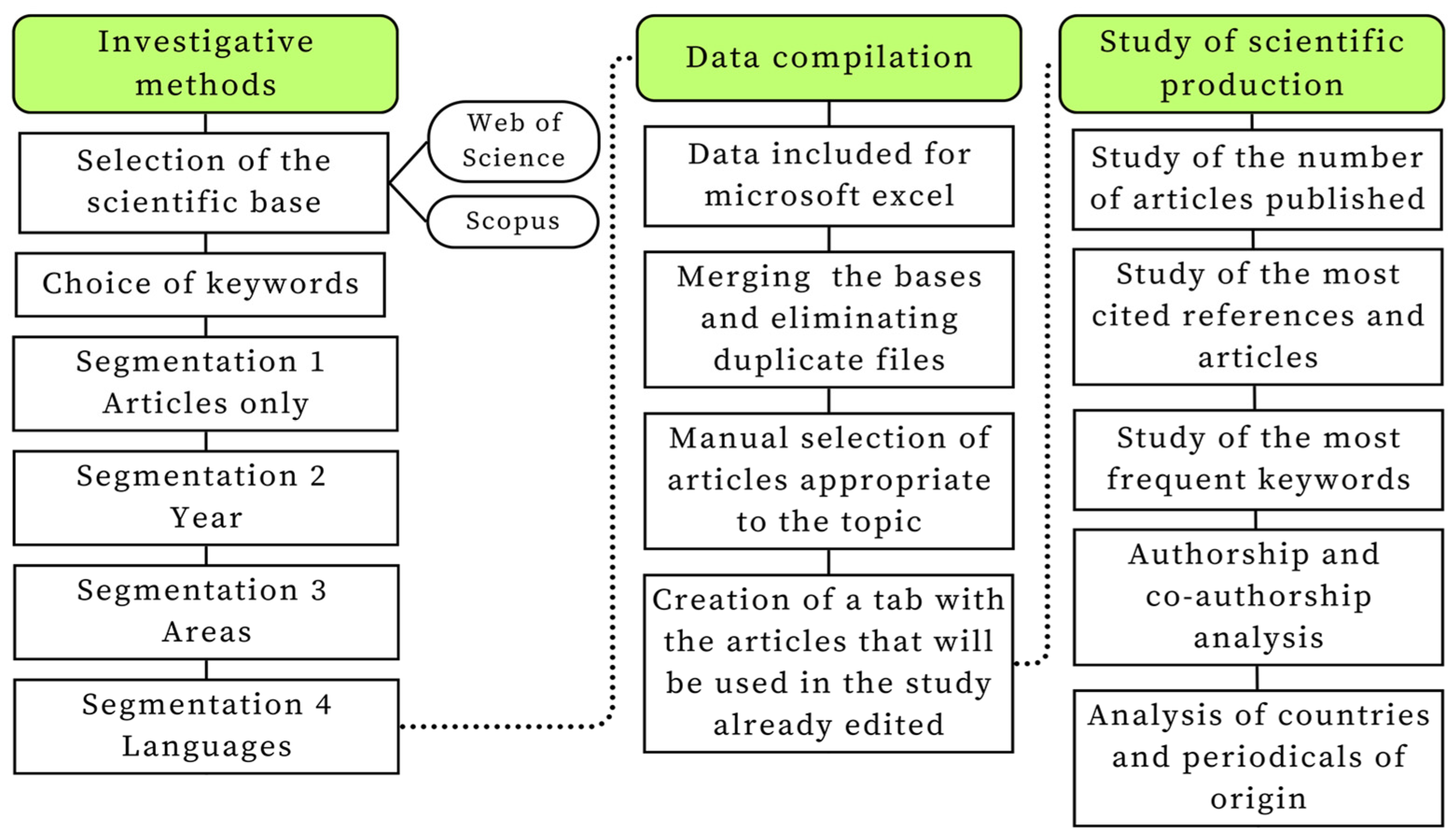
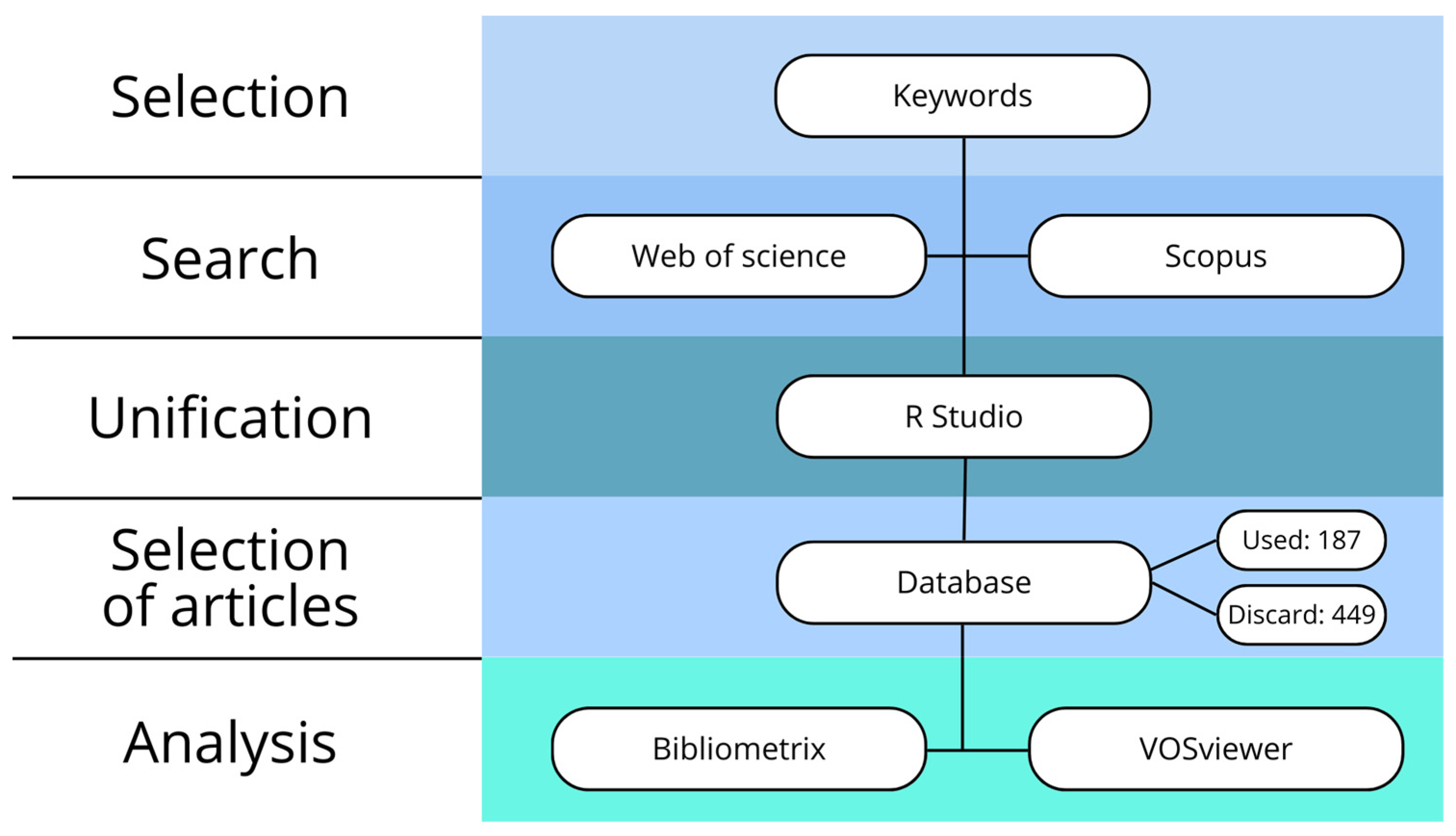
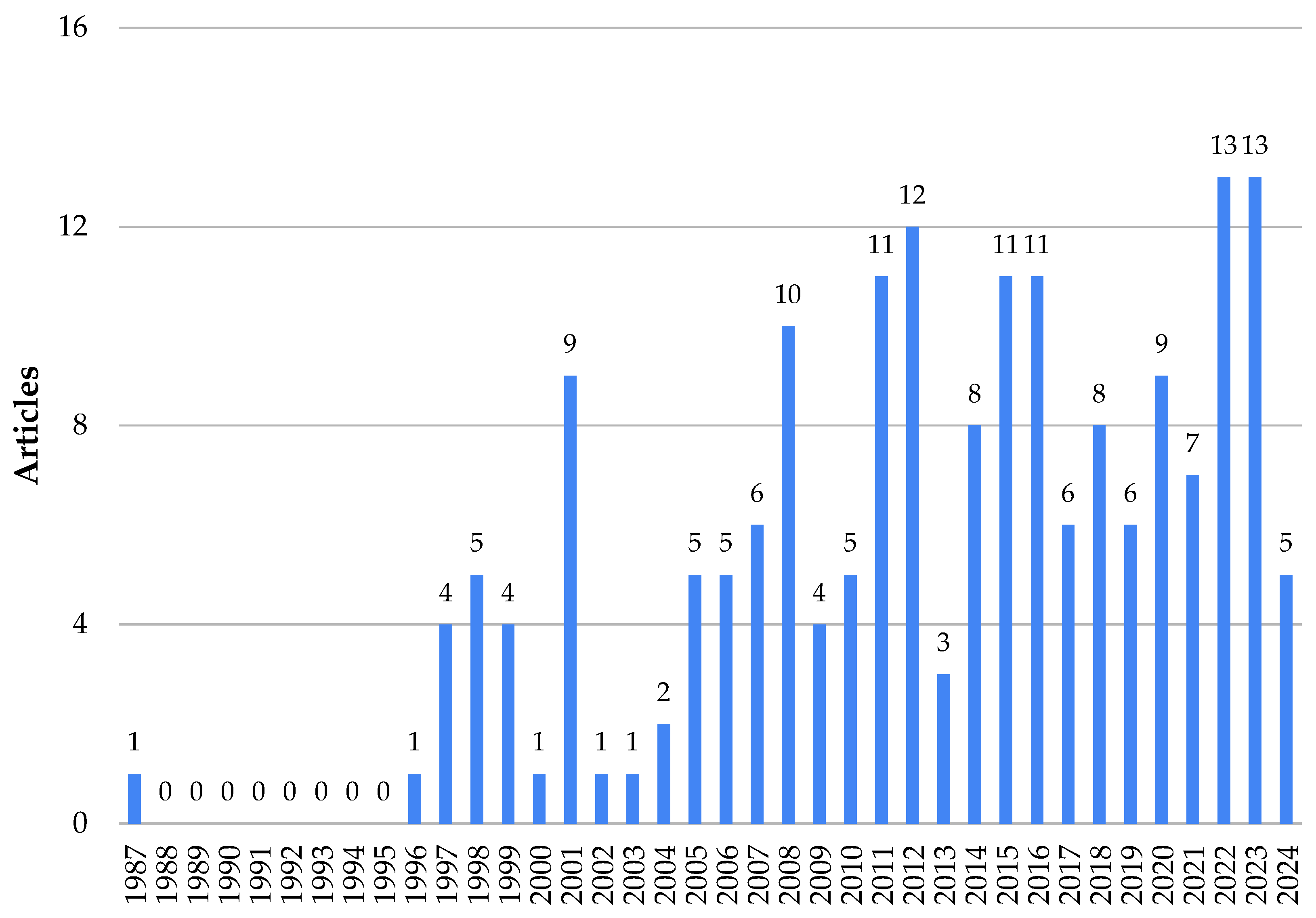
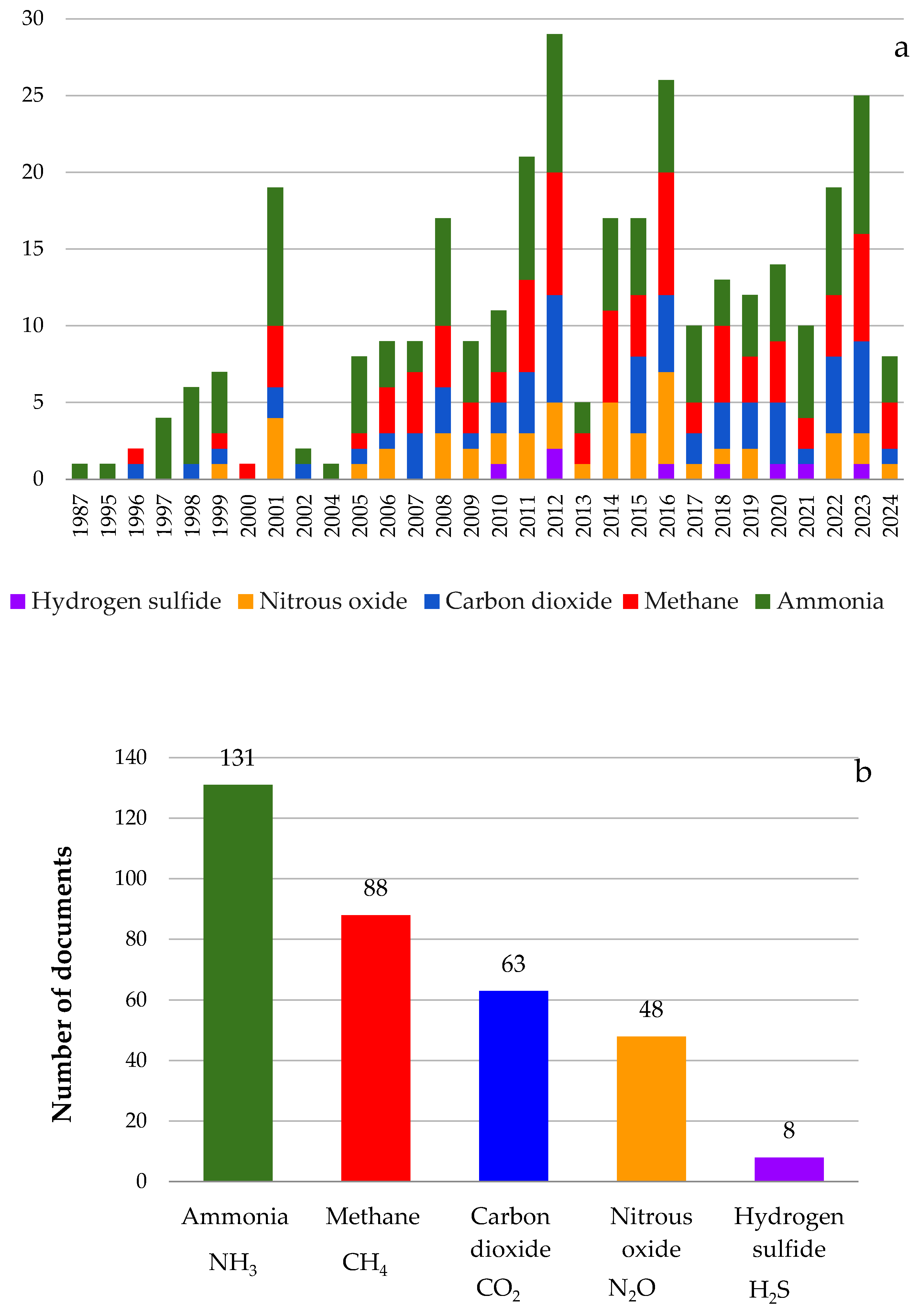
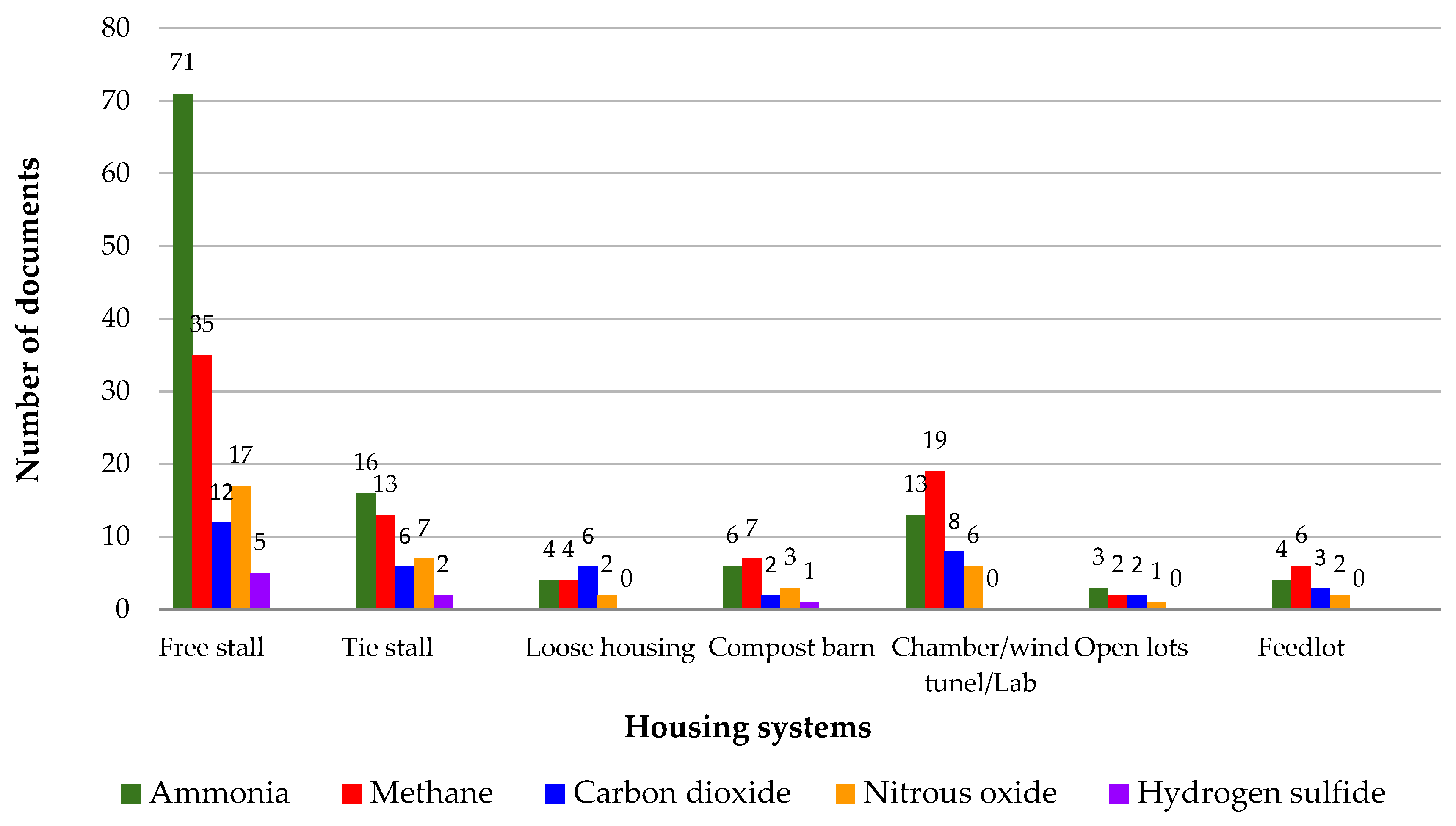
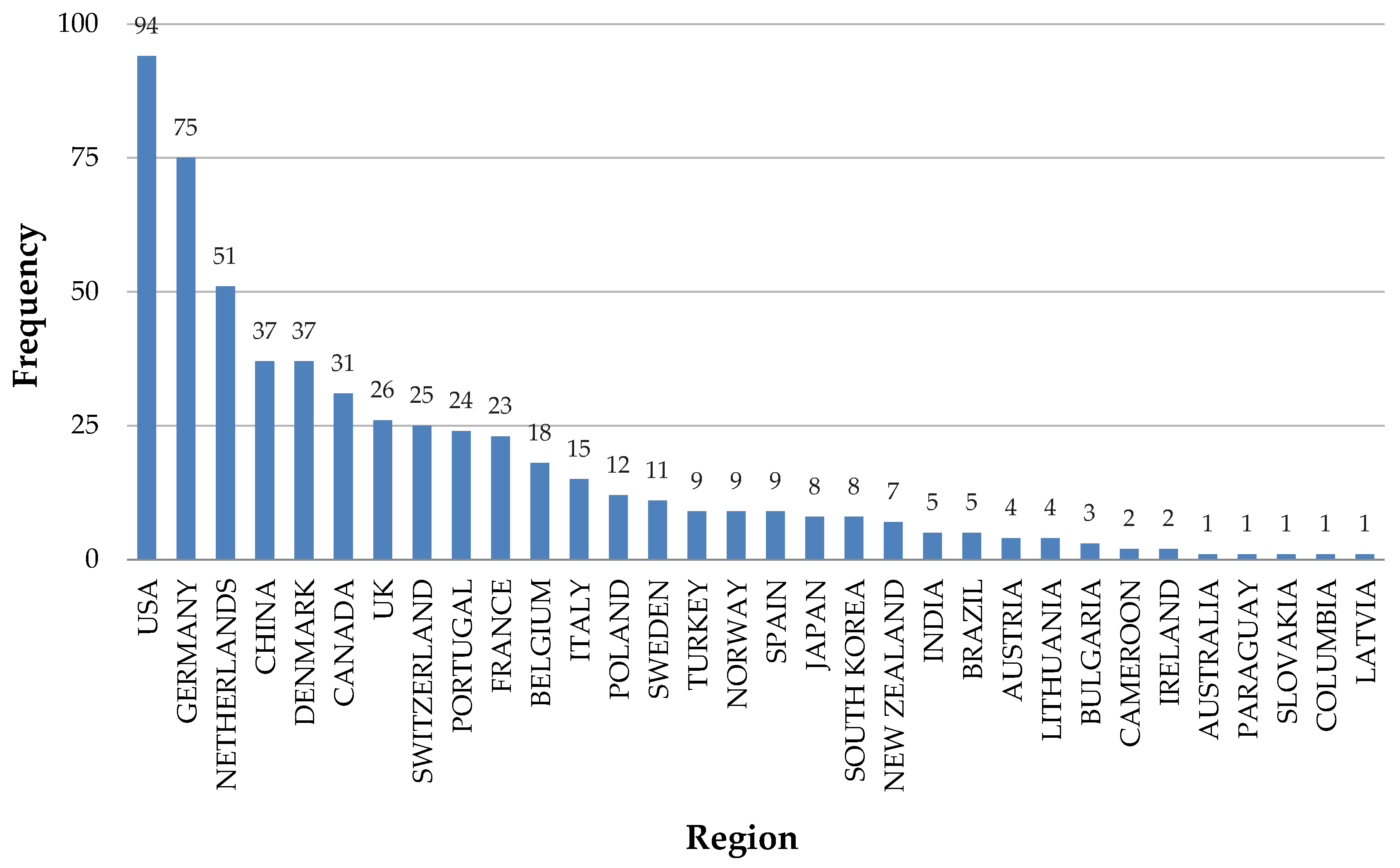
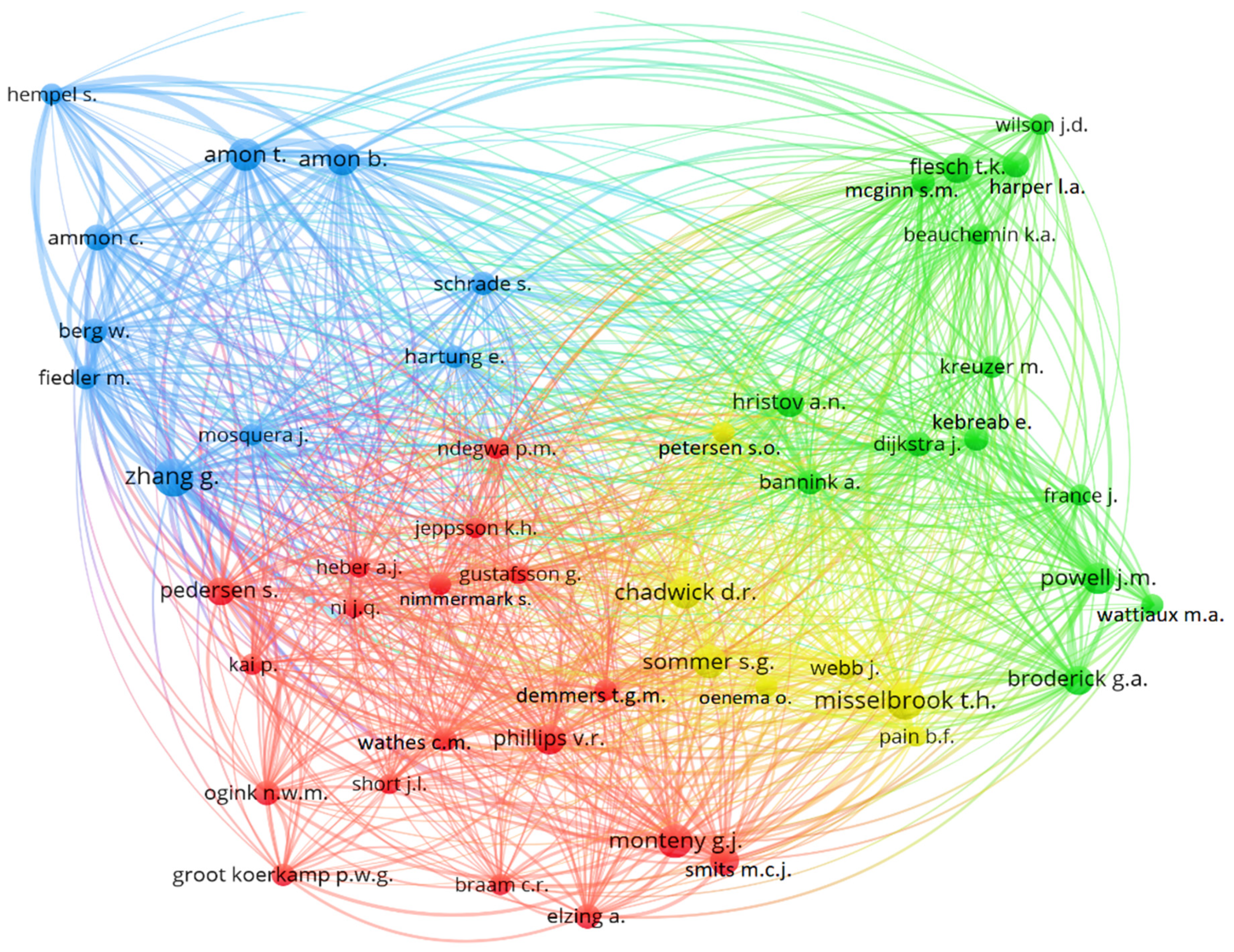
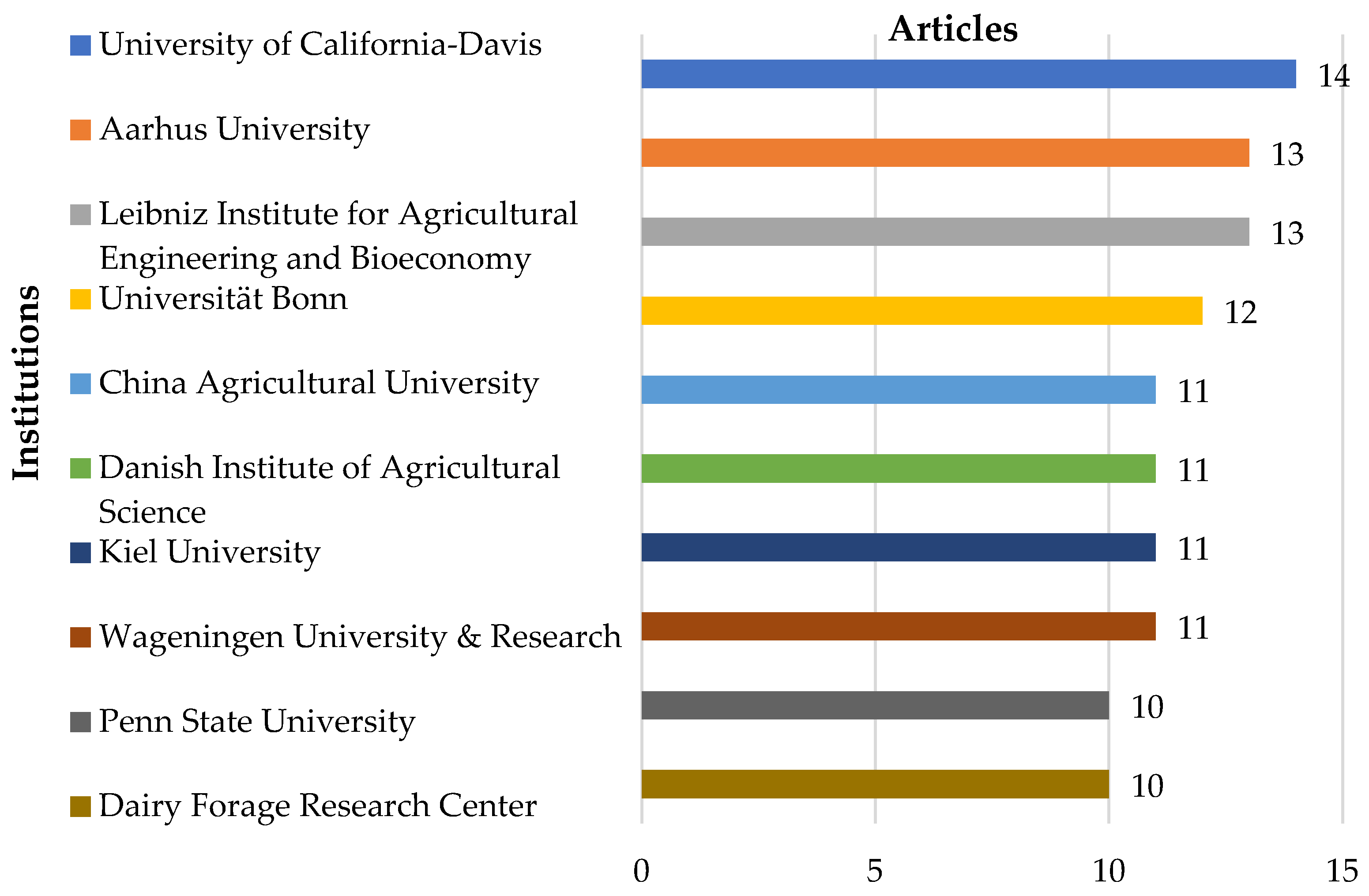

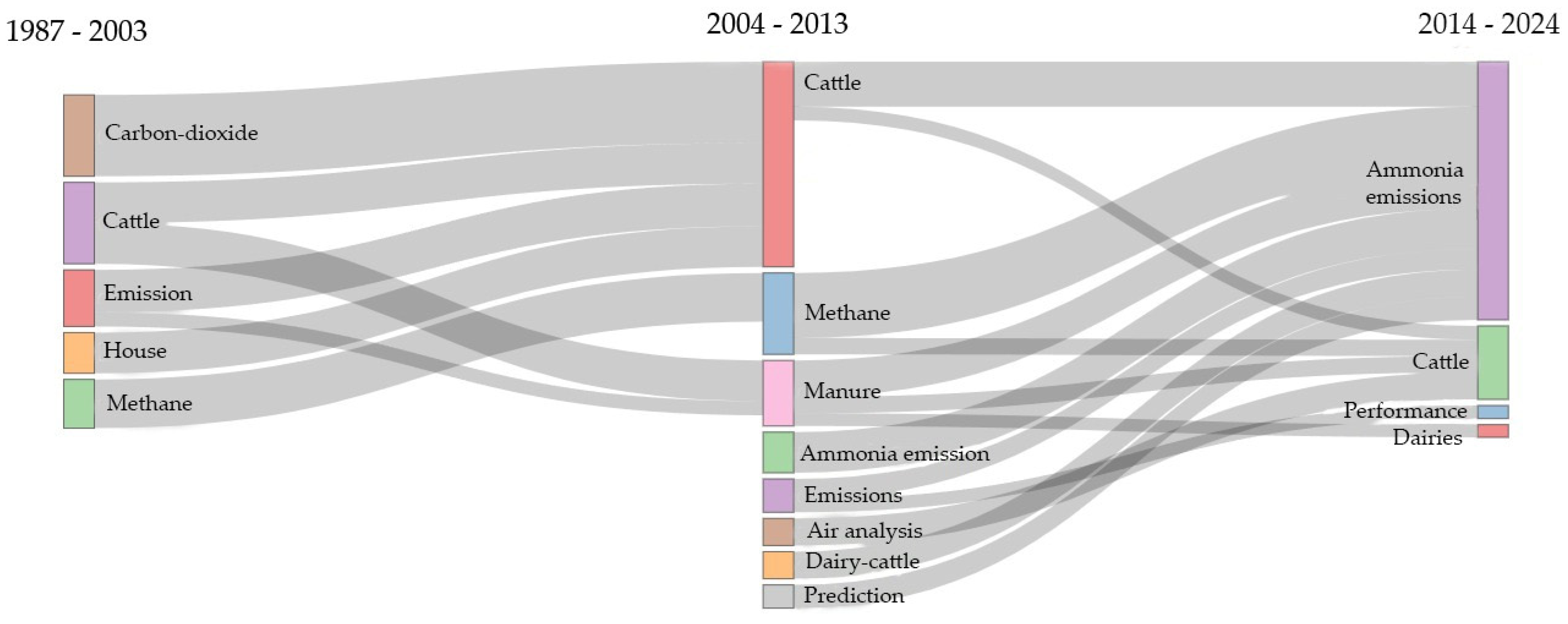
| Sources | SJR 1 | Cite Score 2 | JCR 3 | H-i | ISSN | ND | NC | |
|---|---|---|---|---|---|---|---|---|
| 1° | Journal of Dairy Science | 1.179 | 7.4 | 3.5 | 216 | 0022-0302 | 21 | 68 |
| 2° | Biosystems Engineering | 1.061 | 10.1 | 5.1 | 125 | 1537-5110 | 15 | 13 |
| 3° | Atmospheric Environment | 1.347 | 10.3 | 5.0 | 270 | 1352-2310 | 14 | 68 |
| 4° | Journal of Environmental Quality | 0.803 | 6.6 | 2.4 | 183 | 0047-2425 | 14 | 15 |
| 5° | Animals | 0.684 | 4.2 | 1.37 | 24 | 2076-2615 | 7 | 34 |
| R | Title | Authors | PY | Journal | NC |
|---|---|---|---|---|---|
| 1° | Emissions of NH3, N2O and CH4 from dairy cows housed in a farmyard manure tying stall (housing, manure storage, manure spreading) | Amon et al. [97] | 2001 | Nutrient Cycling Agroecosystems | 193 |
| 2° | Effect of forage to concentrate ratio in dairy cow diets on emission of methane, carbon dioxide and ammonia, lactation performance and manure excretion | Aguerre et al. [30] | 2011 | Journal of Dairy Science | 164 |
| 3° | Ammonia emission from field applied manure and its reduction | Sommer et al. [98] | 2001 | European Journal Agronomy | 155 |
| 4° | Emissions of ammonia, methane, carbon dioxide, and nitrous oxide from dairy cattle housing and manure management systems | Leytem et al. [99] | 2011 | Journal Environment Quality | 141 |
| 5° | Emission of ammonia and other contaminant gases from naturally ventilated dairy cattle buildings | Zhang et al. [100] | 2005 | Biosystems Engineering | 125 |
| 6° | Mitigation of greenhouse gas emissions in European conventional and organic dairy farming | Weiske et al. [101] | 2006 | Agriculture, Ecosystems & Environment | 125 |
| 7° | Long-term effects of feeding monensin on methane production in lactating dairy cows | Odongo et al. [102] | 2007 | Journal of Dairy Science | 119 |
| 8° | Greenhouse gas emission and nitrogen turnover in stored liquid manure nutrient cycling in agroecosystems | Sommer et al. [103] | 2007 | Nutrient Cycling Agroecosystems | 115 |
| 9° | Greenhouse gas emissions from animal houses and manure stores | Jungbluth et al. [104] | 2001 | Nutrient Cycling Agroecosystems | 108 |
| 10° | Volatile organic compound emissions from dairy cows and their waste as measured by proton-transfer-reaction mass spectrometry | Shaw et al. [105] | 2007 | Environmental Science & Technology | 96 |
Disclaimer/Publisher’s Note: The statements, opinions and data contained in all publications are solely those of the individual author(s) and contributor(s) and not of MDPI and/or the editor(s). MDPI and/or the editor(s) disclaim responsibility for any injury to people or property resulting from any ideas, methods, instructions or products referred to in the content. |
© 2024 by the authors. Licensee MDPI, Basel, Switzerland. This article is an open access article distributed under the terms and conditions of the Creative Commons Attribution (CC BY) license (https://creativecommons.org/licenses/by/4.0/).
Share and Cite
Ferraz, P.F.P.; Ferraz, G.A.e.S.; Ferreira, J.C.; Aguiar, J.V.; Santana, L.S.; Norton, T. Assessment of Ammonia Emissions and Greenhouse Gases in Dairy Cattle Facilities: A Bibliometric Analysis. Animals 2024, 14, 1721. https://doi.org/10.3390/ani14121721
Ferraz PFP, Ferraz GAeS, Ferreira JC, Aguiar JV, Santana LS, Norton T. Assessment of Ammonia Emissions and Greenhouse Gases in Dairy Cattle Facilities: A Bibliometric Analysis. Animals. 2024; 14(12):1721. https://doi.org/10.3390/ani14121721
Chicago/Turabian StyleFerraz, Patricia Ferreira Ponciano, Gabriel Araújo e Silva Ferraz, Jacqueline Cardoso Ferreira, João Victor Aguiar, Lucas Santos Santana, and Tomas Norton. 2024. "Assessment of Ammonia Emissions and Greenhouse Gases in Dairy Cattle Facilities: A Bibliometric Analysis" Animals 14, no. 12: 1721. https://doi.org/10.3390/ani14121721






